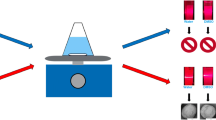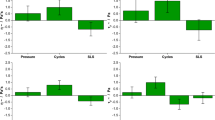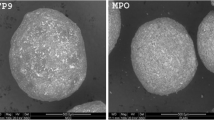Abstract
The wet-state particle size of microcrystalline cellulose (MCC) dispersed in different moistening liquids was characterized to elucidate the effect of moistening liquid type on the extent of MCC particle de-aggregation. Cohesive strength of moistened MCC masses was also assessed and pellet production by extrusion–spheronization attempted. MCC dispersed in alcohol or water–alcohol mixtures with higher alcohol proportions generally had larger particle sizes. Moistened mass cohesive strength decreased and poorer quality pellets were obtained when water–alcohol mixtures with higher alcohol proportions were used as the moistening liquid. MCC comprise aggregates of small sub-units held together by hydrogen bonds. As MCC particle de-aggregation involves hydrogen bond breaking, moistening liquids with lower polarity, such as water–alcohol mixtures with higher alcohol proportions, induced lesser de-aggregation and yielded MCC with larger particle sizes. When such water–alcohol mixtures were employed during extrusion–spheronization with MCC, the larger particle size of MCC and lower surface tension of the moistening liquid gave rise to moistened masses with lower cohesive strength. During pelletization, agglomerate growth by coalescence and closer packing of components by particle rearrangement would be limited. Thus, weaker, less spherical pellets with smaller size and wider size distribution were produced.






Similar content being viewed by others
REFERENCES
Dukić-Ott A, Remon JP, Foreman P, Vervaet C. Immediate release of poorly soluble drugs from starch-based pellets prepared via extrusion/spheronisation. Eur J Pharm Biopharm. 2007;67(3):715–24.
Sinha VR, Agrawal MK, Kumria R. Influence of formulation and excipient variables on the pellet properties prepared by extrusion spheronization. Curr Drug Deliv. 2005;2(1):1–8.
Sarkar S, Heng PWS, Liew CV. Insights into the functionality of pelletization aid in pelletization by extrusion–spheronization. Pharm Dev Technol. 2013;18(1):61–72.
Sarkar S, Ang BH, Liew CV. Influence of starting material particle size on pellet surface roughness. AAPS PharmSciTech. 2014;15(1):131–139.
Soh JLP, Chen F, Liew CV, Shi D, Heng PWS. A novel preformulation tool to group microcrystalline celluloses using artificial neural network and data clustering. Pharm Res. 2004;21(12):2360–8.
Koo OMY, Heng PWS. The influence of microcrystalline cellulose grade on shape and shape distributions of pellets produced by extrusion–spheronization. Chem Pharm Bull. 2001;49(11):1383–7.
Millili GP, Schwartz JB. The strength of microcrystalline cellulose pellets: the effect of granulating with water/ethanol mixtures. Drug Dev Ind Pharm. 1990;16(8):1411–26.
Chatlapalli R, Rohera BD. Physical characterization of HPMC and HEC and investigation of their use as pelletization aids. Int J Pharm. 1998;161(2):179–93.
Schroder M, Kleinebudde P. Structure of disintegrating pellets with regard to fractal geometry. Pharm Res. 1995;12(11):1694–700.
Nakai Y, Fukuoka E, Nakajima S, Yamamoto K. Crystallinity and physical characteristics of microcrystalline cellulose. II. Fine structure of ground microcrystalline cellulose. Chem Pharm Bull. 1977;25(10):2490–6.
Mascia S, Seiler C, Fitzpatrick S, Wilson DI. Extrusion–spheronisation of microcrystalline cellulose pastes using a non-aqueous liquid binder. Int J Pharm. 2010;389(1–2):1–9.
Sarkar S, Wong TW, Liew CV. Importance of wet packability of component particles in pellet formation. AAPS PharmSciTech. 2013;14(3):1267–77.
French AD, Miller DP, Aabloo A. Miniature crystal models of cellulose polymorphs and other carbohydrates. Int J Biol Macromol. 1993;15(1):30–6.
Cousins SK, Brown Jr RM. Cellulose I microfibril assembly: computational molecular mechanics energy analysis favours bonding by van der Waals forces as the initial step in crystallization. Polym. 1995;36(20):3885–8.
Ek R, Alderborn G, Nyström C. Particle analysis of microcrystalline cellulose: differentiation between individual particles and their agglomerates. Int J Pharm. 1994;111(1):43–50.
Luukkonen P, Schæfer T, Hellén L, Juppo AM, Yliruusi J. Rheological characterization of microcrystalline cellulose and silicified microcrystalline cellulose wet masses using a mixer torque rheometer. Int J Pharm. 1999;188(2):181–92.
Dyer AM, Khan KA, Aulton ME. Effect of the drying method on the mechanical and drug release properties of pellets prepared by extrusion–spheronization. Drug Dev Ind Pharm. 1994;20(20):3045–68.
Soh JLP, Liew CV, Heng PWS. Torque rheological parameters to predict pellet quality in extrusion–spheronization. Int J Pharm. 2006;315(1–2):99–109.
Åkerlöf G. Dielectric constants of some organic solvent–water mixtures at various temperatures. J Am Chem Soc. 1932;54(11):4125–39.
Ouchiyama N, Tanaka T. The probability of coalescence in granulation kinetics. Ind Eng Chem Process Des Dev. 1975;14(3):286–9.
Ouchiyama N, Tanaka T. Kinetic analysis and simulation of batch granulation. Ind Eng Chem Process Des Dev. 1982;21(1):29–35.
Ouchiyama N, Tanaka T. Physical requisite to appropriate granule growth rate. Ind Eng Chem Process Des Dev. 1982;21(1):35–7.
Rumpf H. Grundlagen und Methoden des Granulierens. Chem Eng Technol. 1958;30:144–58.
ACKNOWLEDGMENTS
The authors wish to acknowledge research funding support from GEA-NUS Pharmaceutical Processing Research Laboratory fund (N-148-000-008-001) and A*STAR SERC grant number 102 161 0049 (R-148-000-157-305).
Author information
Authors and Affiliations
Corresponding author
Rights and permissions
About this article
Cite this article
Sarkar, S., Liew, C.V. Moistening Liquid-Dependent De-aggregation of Microcrystalline Cellulose and Its Impact on Pellet Formation by Extrusion–Spheronization. AAPS PharmSciTech 15, 753–761 (2014). https://doi.org/10.1208/s12249-014-0098-7
Received:
Accepted:
Published:
Issue Date:
DOI: https://doi.org/10.1208/s12249-014-0098-7




